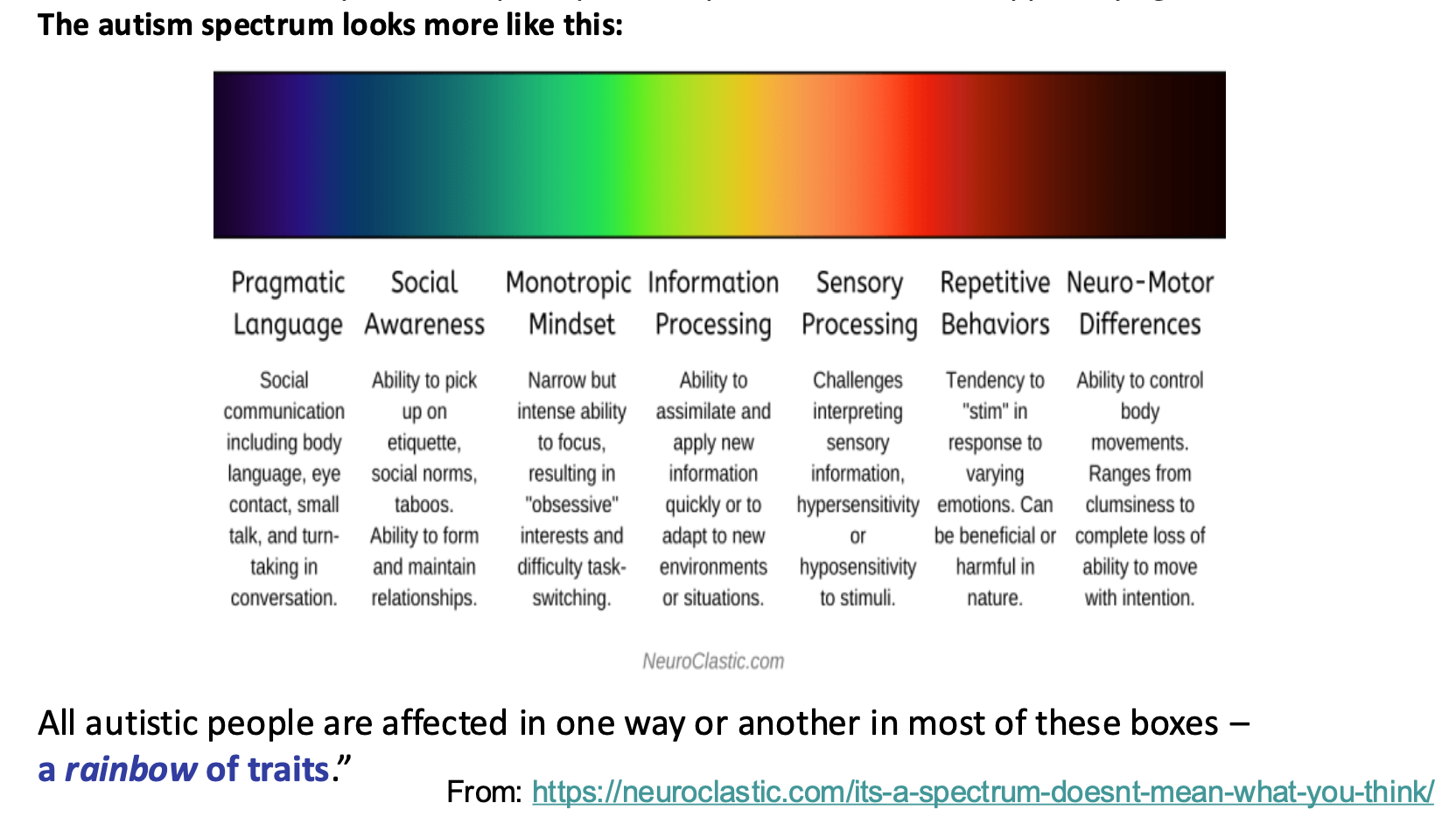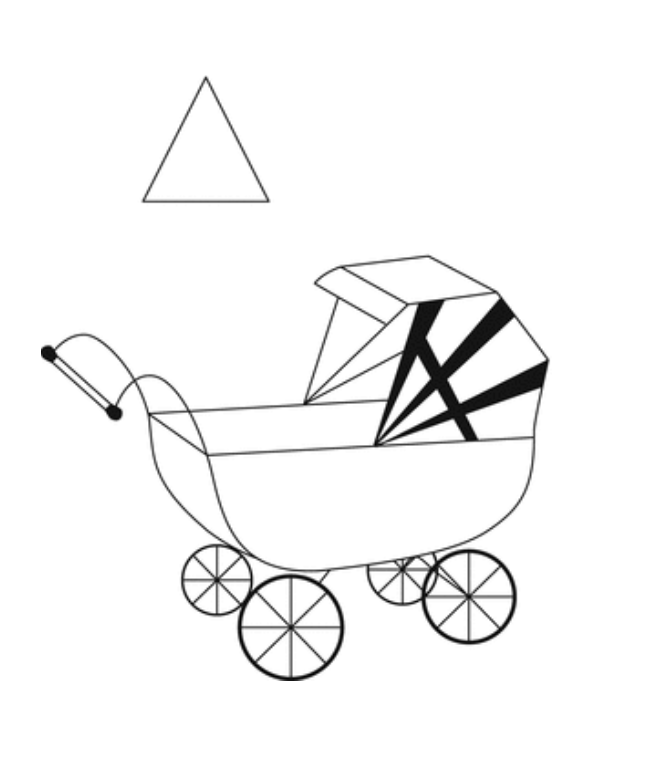Autism Spectrum Disorder (ASD)
1/23
There's no tags or description
Looks like no tags are added yet.
Name | Mastery | Learn | Test | Matching | Spaced |
|---|
No study sessions yet.
24 Terms
ASD characteristics: disorder type, symptoms (2), onset, duration
Complex neurodevelopmental disorder
Challenges in social interaction + communication
Stereotyped (repetitive + non-goal directed) behaviours + interests
Present in early life
Life-long
How diagnosed (1)
No biological markers so based on behaviour
DSM-5 criteria (5, A - E)
A. Deficits in social communication + interaction (all 3)
B. Restricted, repetitive patterns of behaviour, interests, or activities (at least 2)
C. Onset: Symptoms present in early developmental period
D. Impairment: Clinically significant in functioning
E. Exclusionary
A. Deficits in social communication + interaction: symptoms (3) w/ examples
Deficits in all 3 of:
Social-emotional reciprocity (social exchange)
Difficulty maintaining conversations, responding to social interaction, emotional sharing
Non-verbal communication behaviours
Atypical eye contact, difficulty understanding gestures
Developing, maintaining + understanding relationships
Difficulty adjusting behaviours to suit context (e.g. playground vs classroom), no interest in forming friendships
B. Restricted, repetitive patterns of behaviour, interests, or activities (4)
Deficits in at least 2 of:
1. Stereotyped or repetitive motor movements, use of objects, or speech
2. Insistence on sameness, inflexible adherence to routines, or ritualized patterns of verbal or nonverbal behaviour
3. Highly restricted, fixated interests that are abnormal in intensity or focus
4. Hyper- or hypo-reactivity to sensory input or unusual interest in sensory aspects of environment
C. Onset (1)
Symptoms must be present in early developmental period
D. Impairment
Symptoms cause clinically significant impairment in social, occupational, or other important areas of current functioning/in daily life
E. Exclusionary (1)
Disturbances not better explained by intellectual disability or global developmental delay
Specifiers description + 3 levels
Used to indicate severity level of disorder
Level 1: requiring support
Level 2: requiring substantial support
Level 3: requiring very substantial support
Prevalence of ASD: % of population, male:female
~1% population
3:1 male to female ratio
Early signs (4) + regression
Lack of social reciprocity
Restricted eye contact
Not responding to name
Limited speech
Minority of cases → regression can occur (normal dev then ‘regress’ to ASD symptoms), but normally present in early dev.
Dimensional approach to understanding ASD (1→1), “rainbow of traits)
View: there is a continuum of ASD traits in general pop. (normally distributed)
Autism Spectrum Quotient (AQ): questionnaire used to measure characteristics of mild autism traits in general pop. (ASD individuals score higher on this)
Rainbow of traits: autism is "a collection of related neurological conditions that are so intertwined and so impossible to pick apart that professionals have stopped trying"

ASD strengths: approach, morals, values, skills, expertise
Attention to detail + thorough/systematic approach
Strong sense of morality + honesty
Trustworthiness, loyalty, kindness
Artistic skills
Expertise in specific areas (maths, creative)
Biological factors: specific genes, heritability
No specific gene/s associated yet (likely a range)
Strong genetic component
Biological differences: head circumference, brain size, neuron numbers, neural connections
Abnormal growth in head circumference in infancy
Overall brain size 2-10% larger
Fewer neurons in amygdala, hippocampus, anterior cingulate, and cerebellum
More interconnectivity within certain areas → specific expertise, less interconnectivity across areas
Influences in prenatal + postnatal environment that increase ASD susceptibility
Parental age
Low birth weight
Multiple births
Maternal infection
Cognitive theories to explain behavioural aspects of autism (3 main, 5 others)
Deficits in Theory of Mind (TOM)
Weak central coherence
Executive dysfunction
Limited inner speech (thinking in pictures)
Systematising/empathising
Context blindness
Monotropism
Double empathy theory
Deficits in Theory of Mind (TOM): TOM def, false-beliefs tasks, limitations (2)
Ability to attribute mental states to self/others
Fail false beliefs task even at age 11 (high-functioning individuals may pass)
Deaf + ID populations also fail false beliefs test
Can’t explain all features of ASD well
Weak Central Coherence (WCC): description, how explains ASD, benefit, note
Difficulty using context to form parts into an integrated whole: analytic processing (parts), as opposed to holistic (context)
Weak CC explains limitations such as not using context to disambiguate information (e.g. difficulty w/ irony/humour)
Benefit/strength: superior performance on tasks where processing by parts is an advantage
Revised theory: suggests preference (not impairment/need) for processing by parts

Executive dysfunction: def, example of evidence, what it explains, limitations (2)
Higher-level processes responsible for goal-directed action
Deficits in EF of ASD individuals:
Difficulty switching to sorting by different category after doing one category
Can explain repetitive behaviours and cognitive inflexibility
Doesn’t explain social features well
Not autism specific
Cure/lack, shifting perspective, alternative approaches (2)
No known cure
Shift towards viewing as condition rather than disorder (difference rather than deficit)
Rather than changing autistic person:
Changing environment to accept/support autistic people
Enhance person-skills environment fit
Goal of intervention strategies (3)
Reduce risk to self/others
Reduce challenging behaviours
Improve social + life skills
Evidence based approaches to ASD management (5)
Structured learning + increasing routine/predictability
Breaking goals/tasks/instructions into small steps
Positive reinforcement
Direct instruction, modelling of social situations + coaching
Promote generalising (applying skills to other situations)
Best practice for principles of early intervention (5) *not vital to know
Begin early (2-4 years)
Family involvement
Multi-disciplinary approach
Individualised approach
Support for transition to school